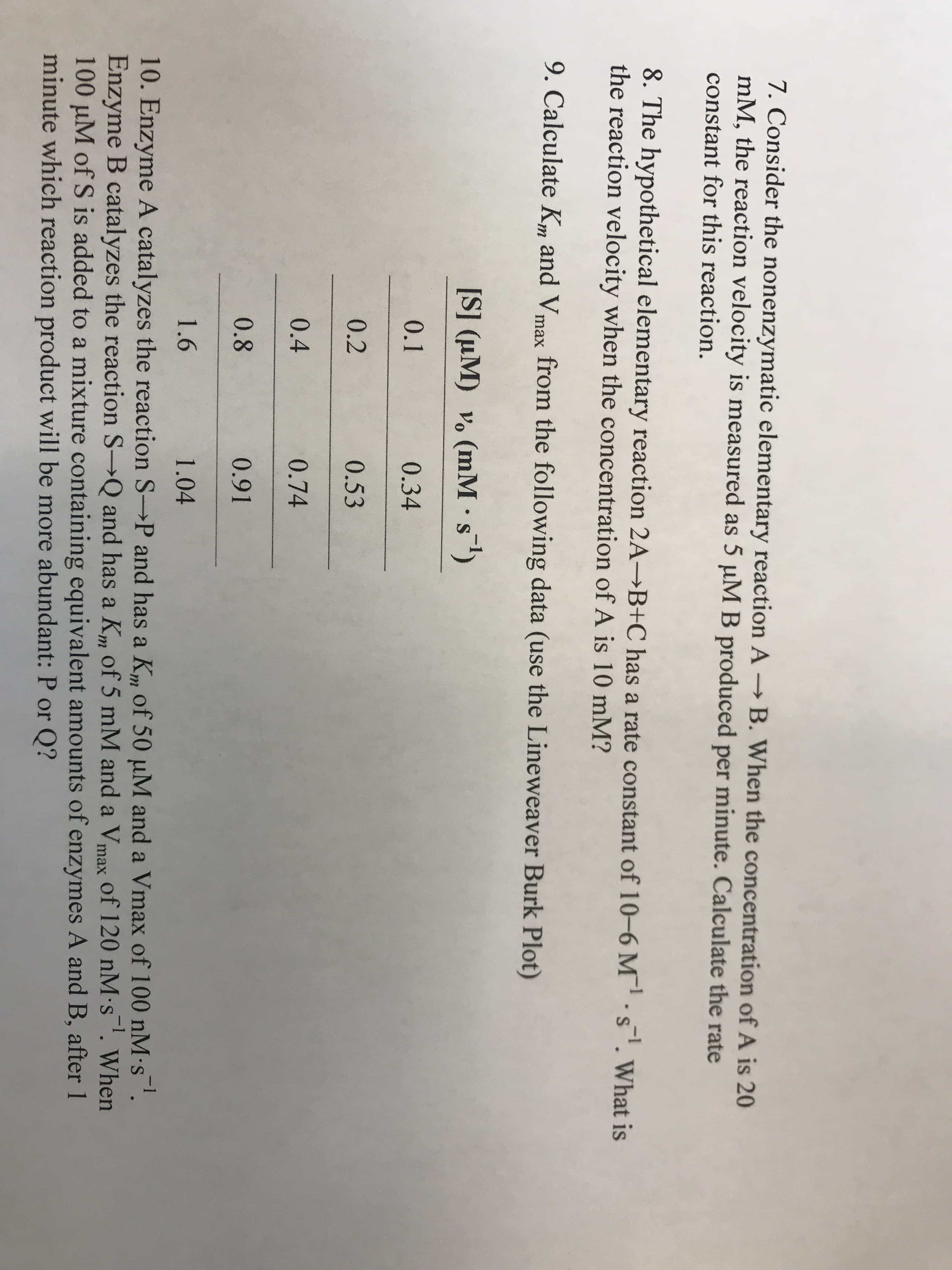7. Consider the nonenzymatic elementary reaction A B. When the concentration of A is 20 mM, the reaction velocity is measured as 5 uM B produced per minute. Calculate the rate constant for this reaction. 8. The hypothetical elementary reaction 2A→B+C has a rate constant of 10-6 M, s-, what is the reaction velocity when the concentration of A is 10 mM? 9. Calculate K,and Vmax from the following data (use the Lineweaver Burk Plot) 0.1 0.2 0.4 0.8 1.6 0.34 0.53 0.74 0.91 1.04 10. Enzyme A catalyzes the reaction S-P and has a K" of 50 uM and a Vmax of 100 nMs". Enzyme B catalyzes the reaction S-Q and has a Km of 5 mM and a Vmax of 120 nM s . When 100 μΜ of S is added to a mixture containing equivalent amounts of enzymes A and B, after 1 minute which reaction product will be more abundant: P or Q?
7. Consider the nonenzymatic elementary reaction A B. When the concentration of A is 20 mM, the reaction velocity is measured as 5 uM B produced per minute. Calculate the rate constant for this reaction. 8. The hypothetical elementary reaction 2A→B+C has a rate constant of 10-6 M, s-, what is the reaction velocity when the concentration of A is 10 mM? 9. Calculate K,and Vmax from the following data (use the Lineweaver Burk Plot) 0.1 0.2 0.4 0.8 1.6 0.34 0.53 0.74 0.91 1.04 10. Enzyme A catalyzes the reaction S-P and has a K" of 50 uM and a Vmax of 100 nMs". Enzyme B catalyzes the reaction S-Q and has a Km of 5 mM and a Vmax of 120 nM s . When 100 μΜ of S is added to a mixture containing equivalent amounts of enzymes A and B, after 1 minute which reaction product will be more abundant: P or Q?
Chemistry: An Atoms First Approach
2nd Edition
ISBN:9781305079243
Author:Steven S. Zumdahl, Susan A. Zumdahl
Publisher:Steven S. Zumdahl, Susan A. Zumdahl
Chapter11: Chemical Kinetics
Section: Chapter Questions
Problem 75E: One mechanism for the destruction of ozone in the upper atmosphere is a. Which species is a...
Related questions
Question
7-10

Transcribed Image Text:7. Consider the nonenzymatic elementary reaction A B. When the concentration of A is 20
mM, the reaction velocity is measured as 5 uM B produced per minute. Calculate the rate
constant for this reaction.
8. The hypothetical elementary reaction 2A→B+C has a rate constant of 10-6 M, s-, what is
the reaction velocity when the concentration of A is 10 mM?
9. Calculate K,and Vmax from the following data (use the Lineweaver Burk Plot)
0.1
0.2
0.4
0.8
1.6
0.34
0.53
0.74
0.91
1.04
10. Enzyme A catalyzes the reaction S-P and has a K" of 50 uM and a Vmax of 100 nMs".
Enzyme B catalyzes the reaction S-Q and has a Km of 5 mM and a Vmax of 120 nM s . When
100 μΜ of S is added to a mixture containing equivalent amounts of enzymes A and B, after 1
minute which reaction product will be more abundant: P or Q?
Expert Solution
This question has been solved!
Explore an expertly crafted, step-by-step solution for a thorough understanding of key concepts.
This is a popular solution!
Trending now
This is a popular solution!
Step by step
Solved in 3 steps with 2 images

Knowledge Booster
Learn more about
Need a deep-dive on the concept behind this application? Look no further. Learn more about this topic, chemistry and related others by exploring similar questions and additional content below.Recommended textbooks for you

Chemistry: An Atoms First Approach
Chemistry
ISBN:
9781305079243
Author:
Steven S. Zumdahl, Susan A. Zumdahl
Publisher:
Cengage Learning


Chemistry
Chemistry
ISBN:
9781305957404
Author:
Steven S. Zumdahl, Susan A. Zumdahl, Donald J. DeCoste
Publisher:
Cengage Learning

Chemistry: An Atoms First Approach
Chemistry
ISBN:
9781305079243
Author:
Steven S. Zumdahl, Susan A. Zumdahl
Publisher:
Cengage Learning


Chemistry
Chemistry
ISBN:
9781305957404
Author:
Steven S. Zumdahl, Susan A. Zumdahl, Donald J. DeCoste
Publisher:
Cengage Learning

Chemistry for Engineering Students
Chemistry
ISBN:
9781337398909
Author:
Lawrence S. Brown, Tom Holme
Publisher:
Cengage Learning

Introductory Chemistry: A Foundation
Chemistry
ISBN:
9781337399425
Author:
Steven S. Zumdahl, Donald J. DeCoste
Publisher:
Cengage Learning

Chemistry & Chemical Reactivity
Chemistry
ISBN:
9781133949640
Author:
John C. Kotz, Paul M. Treichel, John Townsend, David Treichel
Publisher:
Cengage Learning